 |
|
The Sumitomo Group Public Affairs Committee strives to support college students’ negotiation skills, assist in upgrading higher education, and contribute to global human resource development through the
Intercollegiate Negotiation Competition.
The 13th Intercollegiate Negotiation Competition was held at Sophia University in Tokyo, November 29th and November 30th, 2014. This year’s competition featured students from 16 schools from all over Japan: Hokkaido University, Tohoku University, University of Tokyo, Hitotsubashi University, Waseda University, Keio University, Sophia University, Chuo University, Gakushuin University, Nihon University, Nagoya University, Kyoto University, Doshisha University, Ritsumeikan University, Osaka University, Kyushu University. There was also a combined team of three Australian universities which also attended after an interval of two years, as well as The University of Hong Kong which joined the competition for the first time. In total, 54 teams, 258 undergraduate and graduate students (178 Japanese students and 80 students competing in English), from these 20 universities, all enthusiastically performed and competed with each other throughout.
|
 |
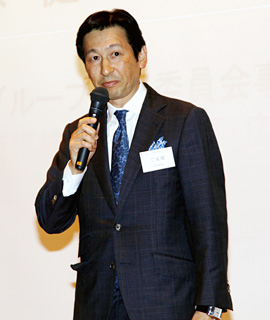
Shinmori Kenji, Representative of the Sumitomo Group Public Affairs Committee
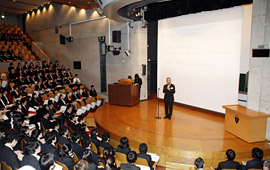
Opening ceremony
|
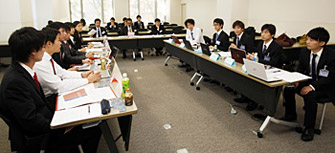
Debate in Japanese
|
 |
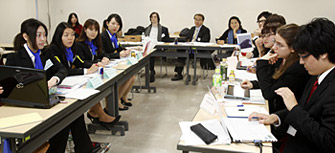
Debate in English
|
Pairing
<Japanese>
|
Round A/arbitration
|
Round B/negotiation
|
|
Red
|
Blue
|
Red
|
Blue
|
|
1
|
Keio1
|
Sophia21
|
Osaka11
|
Kyoto11
|
|
2
|
Tohoku1
|
Chuo3
|
Tohoku3
|
Nagoya2
|
|
3
|
Ritsumeikan1
|
Waseda1
|
Hongkong
|
Sophia1
|
|
4
|
Tokyo2
|
Kyoto2
|
Hitotsubashi2
|
Hokkaido1
|
|
5
|
Ritsumeikan2
|
Chuo1
|
Osaka2
|
Chuo1
|
|
6
|
Hitotsubashi1
|
Nihon1
|
Tohoku2
|
Australia
|
|
7
|
Hongkong
|
Kyoto1
|
Gakushuin1
|
Nihon1
|
|
8
|
Kyushu
|
Chuo2
|
Tokyo1
|
Waseda2
|
|
9
|
Tohoku2
|
Hokkaido1
|
Gakushuin2
|
Waseda3
|
|
10
|
Hitotsubashi2
|
Australia
|
Keio2
|
Kyoto2
|
|
11
|
Gakushuin1
|
Nagoya1
|
Tohoku1
|
Nihon2
|
|
12
|
Kyushu2
|
Doshisha
|
Ritsumeikan2
|
Hokkaido2
|
|
13
|
Gakushuin2
|
Sophia1
|
Kyushu1
|
Waseda1
|
|
14
|
Tohoku3
|
Waseda2
|
Keio1
|
Chuo3
|
|
15
|
Keio2
|
Nihon2
|
Tokyo2
|
Chuo2
|
|
16
|
Osaka1
|
Hokkaido2
|
Hitotsubashi1
|
Sophia2
|
|
17
|
Tokyo1
|
Nagoya2
|
Kyushu2
|
Nagoya1
|
|
18
|
Osaka2
|
Waseda3
|
Ritsumeikan1
|
Doshisha
|
<English>
|
Round A/arbitration
|
Round B/negotiation
|
|
Red
|
Blue
|
Red
|
Blue
|
|
1
|
Ritsumeikan
|
Australia2
|
Gakushuin
|
Kyoto
|
|
2
|
Osaka
|
Australia1
|
Tokyo
|
Sophia1
|
|
3
|
Tohoku
|
Sophia1
|
Osaka
|
Nagoya
|
|
4
|
Keio
|
Nagoya
|
Keio
|
Waseda
|
|
5
|
Tokyo
|
Doshisha
|
Ritsumeikan
|
Sophia2
|
|
6
|
Kyushu
|
Sophia2
|
Hitotsubashi
|
Chuo
|
|
7
|
Hitotsubashi
|
Kyoto
|
Hongkong
|
Australia1
|
|
8
|
Gakushuin
|
Chuo
|
Tohoku
|
Doshisha
|
|
9
|
Hongkong
|
Waseda
|
Kyushu
|
Australia2
|
|
Problem establishment and competition outline (Red vs. Blue companies)
|
The competition is separated into two major parts, Round A which is the “arbitration” round, and a Round B which serves as the “negotiation” portion, with each part having both a Japanese and English version. Each team was divided into two sides, the Red company in the fictional country of Negoland and the Blue company in Arbitria, a neighboring country of Negoland with the competition based on the negotiated business between both companies. The Red company was originally a chocolate business. Now they produce and sell various chocolates such as a chocolate that improves weight loss and enlarged their field of business and holdings to sporting goods through mergers and acquisitions. On the other side, the Blue company started in the cake and dairy businesses, and went into the beverage industry in 2000. The Blue beverage subsidiary took over the drink side of the business for the Blue company and released the sports drink, "Blue Energy" and the fat burning drink, "Blue Slim", with both drinks being a hot seller.
On the first day in Round A, the teams aimed to resolve various challenges through "Arbitration" and very passionately argued their points and proposals. The points of the discussions were around "the chocolate case", which concerned the problems caused from the sales agreement of chocolates between the Red company and the Blue company, and "the M&A case", which concerned the challenges arising from mergers and acquisitions, when the Red company purchased the Blue Drink company from the Blue company. On the second day in Round B, during the "Negotiation" portion of the competition, they debated on an agreement for five problems that remained and came to a conclusion through the use of such business practices as a Letter of Intent and using due diligence for solving "the M&A case". It was training for a negotiation in a real business format which looked and felt extremely accurate comparable to a real world negotiation.
|
Judges
|
Every year, this competition receives assistance from many people and groups in judicial circles, professionals from each of the participating universities as well as the Judicial Affairs Divisions of various corporations who serve as judges for the competition. The comments from the judges after the enthusiastic performance have always been a wonderful opportunity for students to receive valuable feedback and grow from the guidance of these professionals. Also recently, the numbers of both male and female alumni of the competition has been growing and now these former competitors serve as judges and staff for the competition, adding to the continued success and growth of the event.
|
Results of the 13th Intercollegiate Negotiation Competition
The awards ceremony is always surrounded by tension and every year contains drama surrounding the announcement of prizes to the delight and tears of the winning team or to the disappointment of the team that was not able to achieve its goal. All teams continue to improve their negotiation skills each year through as the competition has grown. This year, all of the teams were nearly equal as in other years but there could only be one winner though and by a narrow margin, Tokyo University became the champion for the second time in a row. Team Australia which attended after an interval of two years away from the competition was able to overcome a challenging Round A by finding success in Round B which earned them the third place prize. There was also a new prize established for “Best teamwork” displayed with Kyushu University winning the prize.
|
The final results for 2014 are as follows:
|
The 1st prize :
|
Tokyo University
|
321 points
|
|
The 2nd prize :
|
Kyushu University
|
319 points
|
|
The 3rd prize :
|
Team Australia
|
316.8 points
|
|
|
The Best Teamwork Award:
|
The 1st prize :
|
Kyushu University
|
|
The 2nd prize :
|
Waseda University
|
|
The 3rd prize :
|
Keio University
|
|
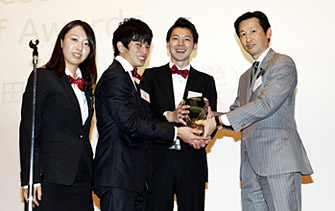
Presentation of championship cup
|
 |
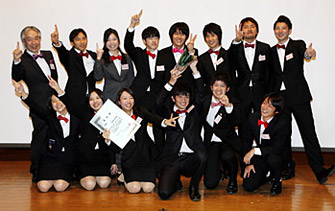
Tokyo University,
winner of the 13th Intercollegiate Negotiation Competition
|
|